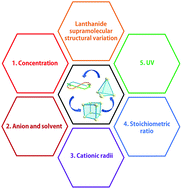Structural variation of self-assembled lanthanide supramolecular complexes induced by reaction conditions
Abstract
The chemistry of lanthanide supramolecular self-assembly has received much attention with many extraordinary structures discovered due to the unique photophysical properties such as the Laporte forbidden f–f transition, large Stokes shift and long luminescence lifetime of lanthanides. Recent investigations have demonstrated the formation of architectures that are highly sensitive towards different stimuli, such as concentration, light, solvent and counter-anions. Various stimuli have been employed extensively for the preparation of desired supramolecular topologies with specific properties. Moreover, transformation from lower order- to higher order-supramolecular systems has also been observed by various stimuli due to the labile nature of lanthanide ions. This review summarizes recent research on the factors that govern the formation of self-assembled lanthanide supramolecules and aims to provide readers with the information required for designing functional lanthanide supramolecular systems.

- This article is part of the themed collections: Recent Open Access Articles in Frontiers Journals and 2021 Inorganic Chemistry Frontiers Review-type Articles


 Please wait while we load your content...
Please wait while we load your content...